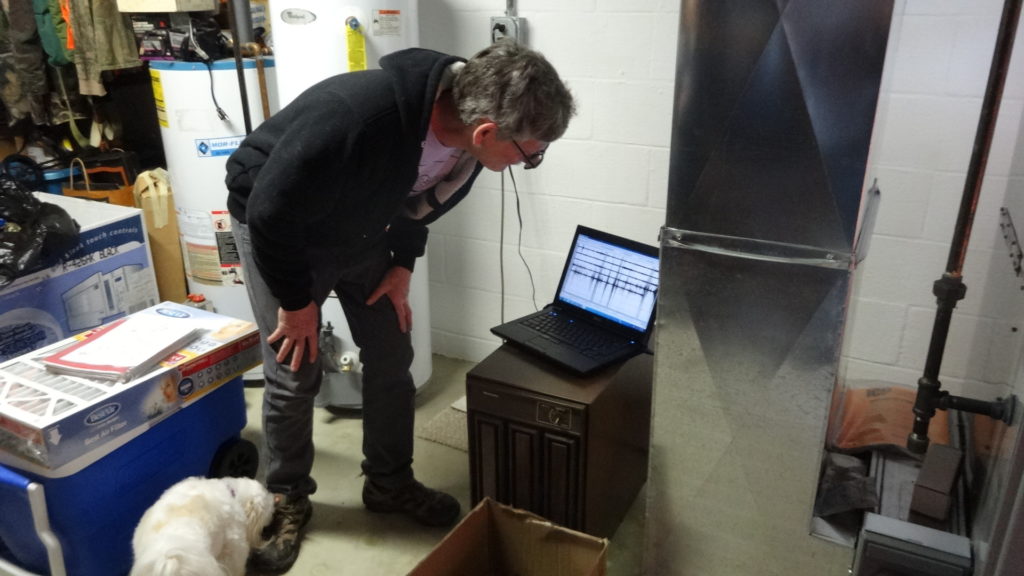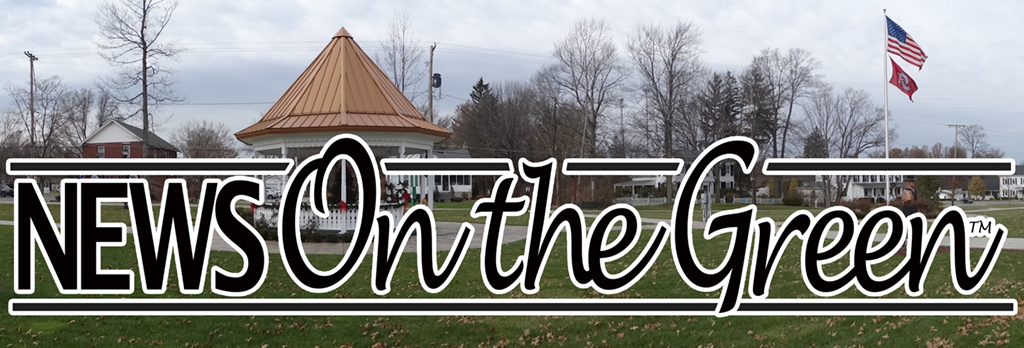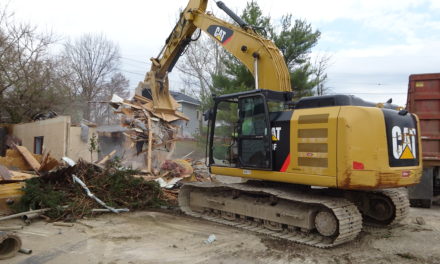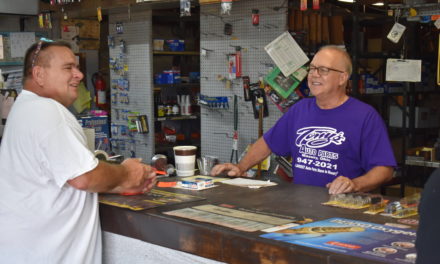John Williams stamped his foot on the concrete floor of Bill Baum’s cellar on Merwin Chase Road in Brookfield and showed where a line appeared on a chart on a laptop computer.
“See how sensitive this is?” he said.
“This” is an Infiltec Model QM seismometer, which measures ground movement. The little metal box about 6 inches long and hooked to a laptop computer will register when the nearby furnace kicks in, Williams said. It probably will register when people walk on the floor upstairs, he said.
“We can filter it out,” he said of a non-natural phenomena.
Williams is hoping to capture earthquakes.
Baum lives on the north side of the injection well property owned by Highland Field Services on Route 7. Williams, who lives in McDonald, also placed a seismometer at Gloria Douglas’s mobile home on the south side of the injection well property, and others in Vienna and McDonald. His hope is that the devices will register whenever residents around the injection well hear another of the loud booms that have been detected on three days since Dec. 31.
Although many possible explanations of the booms have been offered, from gunshots to shifting ice, injection well opponents assert they could be small, shallow earthquakes, sometimes called “Seneca guns,” which are described on the U.S. Geological Survey web site.

“If we hear a boom, we got ’em,” said Williams, who also asked that anyone who hears booms record the time so that seismometer readings can be compared with those times.
Williams is a not a geologist or university professor and has not been trained by anyone certified to use the seismometers, which he said he bought with his first Social Security check after he retired. He’s a member of Frackfree Mahoning Valley, Frackfree American National Coalition and Buckeye Environmental Network, groups that oppose fracking, a process of natural gas and oil extraction, and injection wells, where waste water generated by fracking is disposed of deep into the earth.
Williams admits he has more to learn about the machines, and eventually wants the boxes to be connected to wifi so readings will be registered with Incorporated Research Institutions for Seismology, a Washington D.C.-based consortium of 120 U.S. Universities.
“I think the best science right now is being done by citizens,” he said.
That’s because data collected by official sources is not always shared with or explained to the general public, he said. The seismometers already placed around the injection well are owned by Highland Field Services LLC, the company that drilled and operates an injection well on Route 7, and is drilling a second well.
“They own the data and they don’t share it,” Williams said.
He also said Highland does not have to report any activity to the Ohio Department of Natural Resources that registers less than 2.0 on the Richter Magnitude Scale.
“This will go down to 1.0,” he said.
Once the data is registered with IRIS, reputable professionals will have access to it and can decipher it for lay people, Williams said.
“I’m one of the guys who believes we gotta use every tool in the tool box,” Williams said.
ODNR spokesman Steve Irwin, who was asked to respond to Williams’ assertions, said ODNR “has installed and monitored seismic stations in northeast Ohio for the past several years.”
The monitors “are capable of detecting seismic events below a 1M threshold,” Irwin said, referring to the Richter Magnitude Scale.
The data from the stations “is transmitted in real-time to our team of professional seismologists and geologists who interpret the data to determine if it is a natural event or induced seismic activity. Our system includes our assets, some federal monitors and the ability to obtain data from stations operated by the oil and gas industry (these monitors are often in place due to permit operating conditions). Our records are public data and have been frequently provided through public records requests.”
Highland spokesman Rob Boulware said seismic monitoring is required for injection well operators and the data from them is “immediately available” to ODNR.
“Most U.S. data collected on seismic events is publicly available,” he said. “The United States Geological Survey manages the National Earthquake Information Center (NEIC) and their data is available on a variety of public sites.”
In Brookfield, ODNR has two seismic monitors, and Highland has three, Boulware said.
“The data for the two monitors owned/operated by ODNR are publicly available,” he said, while Highland’s monitor data “is made immediately available to ODNR for their review/analysis should a seismic event occur.”
ODNR has similar arrangements with other injection well operators, Boulware said.
Concerning citizen owned monitors, Boulware said, “Although nearby landowners are free to set up their own seismic monitoring equipment on their properties, placing such equipment in a basement may not be ideal as it could result in false-positives due to equipment at the property (eg., furnace/AC/wash machine). Most professional monitoring equipment is generally placed six to 10 feet below ground to help avoid such false readings.”
@@@
ODNR releases first injection volume report for well
The Highland Field Services injection well in Brookfield disposed of 64,708 barrels of brine, the waste water generated by fracking well-drilling operations, during the last quarter of 2018, the first period of the well’s operation, said a spokesman for the Ohio Department of Natural Resources.
Highland was required to make its first report of disposal volumes on Jan, 31, said spokesman Steve Irwin.

ODNR issued a “chief’s order” allowing injection on Oct. 22 for what is known as well number five, a reference to the five wells that Highland was at one point permitted to drill on the property. Two permits have expired.
Highland is drilling a second well, known as number four, on the property on Route 7.
“The rig drilling the Highland Brookfield #4 encountered some issues and was swapped for another rig,” Irwin said on Feb. 20. “The well should reach total depth this week, at which point the company will log the well.”
By logging the well, the company will ensure that proper depth has been achieved, that the well has been properly constructed and that the brine will be injected into rock of proper porosity, he said. The fluid is supposed to be released into porous rock that is sandwiched between two denser layers of rock.
Company spokesman Rob Boulware said the logging is required in regulations that ODNR adopted after the earthquakes linked to the Northstar injection well in Youngstown. Drilling is prohibited in Precambrian basement rock, an attempt to avoid any geologic faults in that rock.
The drilling has brought complaints from areas residents about the constant noise and lights that shine on neighboring properties at night.
“People out there are losing sleep left and right,” said Gloria Douglas of Brookfield Citizens Against Injection Wells, which has filed an appeal of ODNR’s chief’s order in an attempt to get the well shut down.
“You could be in a sound sleep and at times it sounds like there’s a helicopter hovering over your house,” Douglas, who lives in Wyngate Manor Mobile Home Park, said at the Feb. 4 trustees meeting. “You’re awakened out of a sound sleep.”
“Highland did install equipment specific sound-proofing to reduce the sound emitted from the drilling operation,” Boulware said.
Highland also is planning “workover operations” in the number five well, Irwin said.
“The operator is pulling the tubing, clearing an obstruction and resetting the packer,” he said. One this work is complete, Highland will have to test the well under the supervision of an ODNR inspector, he said.
James Yskamp of Fair Shake Environmental Legal Services, Akron, the law firm representing the citizens group in the appeal, said the parties are in the discovery phase, where they share information. A hearing on the appeal has been set for Aug. 12 and 13, he said.








